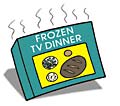|
Many people were a part of the original concept of manufacturing a complete meal that needs only to be reheated before eating. While the idea may not be either as old or as earth-shattering as the discovery of fire or the invention of the wheel, the TV dinner can trace its origins back to the days of early television. The idea has been attributed to at least three different sources, primarily Gerry Thomas, the Swanson Brothers and Maxson Food Systems. Some sources indicate that Gerry Thomas, acting alone and with no malice aforethought, invented both the name of the Swanson TV dinner and the product. That may be so, but consider some of these alleged facts, even if they may be a bit frozen in some cases and a bit soggy in others.
 In 1945, Maxson Food Systems, Inc. manufactured the very first complete frozen meals in what were known as "Strato Plates." Military and civilian passengers consumed them on airlines and they only required reheating before serving (the plates, not the passengers). The meals consisted of three parts: meat, vegetable and potato, each given its own special, third class compartment on the plate. The concept never hit the retail market due to lack of funding and the death of Maxson. Some experts argue that Maxson’s creations do not qualify as true TV dinners because they were consumed on airplanes and not in homes while watching television. (A moot, if not frozen point.) In 1945, Maxson Food Systems, Inc. manufactured the very first complete frozen meals in what were known as "Strato Plates." Military and civilian passengers consumed them on airlines and they only required reheating before serving (the plates, not the passengers). The meals consisted of three parts: meat, vegetable and potato, each given its own special, third class compartment on the plate. The concept never hit the retail market due to lack of funding and the death of Maxson. Some experts argue that Maxson’s creations do not qualify as true TV dinners because they were consumed on airplanes and not in homes while watching television. (A moot, if not frozen point.)
In 1952, the first frozen meals made their chilled appearance on the retail market. These meals were also divided into three sections like the Maxson predecessor, but they were packaged in aluminum oven-ready trays. Quaker State Foods were the first to feature these dinners and they sold them under the "One-Eye Eskimo Label." (One can only wonder how well such a product could do if more than one Eskimo with more than one eye wanted to buy it?) Frigi-dinner also began offering its own line of frozen dinners at about the same time.
 The TV dinner actually grabbed the ears, nose, mouth, heart and stomach of the retail world in 1954 when Swanson frozen meals first displayed their icy faces in the frozen food sections of the supermarket. At the time, C. A. Swanson and Sons was a subsidiary of the Campbell Soup Company. A well-established name that customers knew and trusted, the company capitalized on that, pushing their product even further through massive advertising campaigns. These meals were featured on television commercials by the top celebrities of the day, including Howdy Doody and even President Eisenhower. The term, TV dinner, turned an everyday meal into a cultural experience and revolutionized the idea of "preparing dinner." The TV dinner actually grabbed the ears, nose, mouth, heart and stomach of the retail world in 1954 when Swanson frozen meals first displayed their icy faces in the frozen food sections of the supermarket. At the time, C. A. Swanson and Sons was a subsidiary of the Campbell Soup Company. A well-established name that customers knew and trusted, the company capitalized on that, pushing their product even further through massive advertising campaigns. These meals were featured on television commercials by the top celebrities of the day, including Howdy Doody and even President Eisenhower. The term, TV dinner, turned an everyday meal into a cultural experience and revolutionized the idea of "preparing dinner."
Gerry Thomas was originally a salesman who was working for Swanson & Sons in 1953, and as mentioned earlier, it is he who is usually credited with the concept of the TV dinner, the design of the tray and the trademark name. Thomas was inducted into the Frozen Food Hall of Fame (no kidding) in Orlando, Florida, where his image is remembered but not frozen in effigy. Still others say differently, proving that truth sometimes can be as clear as mud.
 Betty Cronin, a bacteriologist who also worked for Swanson Brothers at that time, claims that it was the brothers Swanson, Gllbert and Clarke to be specific, who came up with the idea of the TV dinner. Cronin herself worked on the project (Operation Frozen Blue Plate Special?). Her technical challenge was synchronization, that is, to compose a dinner in which all the ingredients took the same time to cook. Betty Cronin, a bacteriologist who also worked for Swanson Brothers at that time, claims that it was the brothers Swanson, Gllbert and Clarke to be specific, who came up with the idea of the TV dinner. Cronin herself worked on the project (Operation Frozen Blue Plate Special?). Her technical challenge was synchronization, that is, to compose a dinner in which all the ingredients took the same time to cook.
Swanson TV dinners came on the wing of two growing post-war trends: the fascination with the new medium of television and the lure of time-saving modern appliances and techniques. During the first year of national distribution, Swanson sold 10 million TV dinners. For less than a dollar (98 cents to be exact), the too busy, lazy or simply uninclined-to-cook consumer could choose to sample Salisbury steak, meatloaf, fried chicken or turkey, served with potatoes and green peas.
 Desserts were not available at this time, but they were added in 1960 and included apple cobbler and brownies in a new four-part tray. In 1969, breakfasts of pancakes and sausage were introduced to an ever waiting frozen public. A metal tray divided all the portions and in 1987, a representative tray was placed in the Smithsonian Institute to commemorate the impact of the TV dinner on the American dining experience. The Swanson "TV dinner" had its swan song in the 1960s and in 1986, the Campbell Soup Company replaced the aluminum trays with plastic microwavable trays. In 1999, Swanson received its very own star on the Hollywood Walk of Fame. Desserts were not available at this time, but they were added in 1960 and included apple cobbler and brownies in a new four-part tray. In 1969, breakfasts of pancakes and sausage were introduced to an ever waiting frozen public. A metal tray divided all the portions and in 1987, a representative tray was placed in the Smithsonian Institute to commemorate the impact of the TV dinner on the American dining experience. The Swanson "TV dinner" had its swan song in the 1960s and in 1986, the Campbell Soup Company replaced the aluminum trays with plastic microwavable trays. In 1999, Swanson received its very own star on the Hollywood Walk of Fame.
The term "TV dinner" became synonymous with any pre-packaged frozen dinner bought in a supermarket and reheated at home. But time waits for no man or TV dinner, and Pinnacle Foods Corporation, the owners of Swanson products since 2001, recently celebrated fifty years of TV dinners.
It may depend on your definition as to who actually invented the TV dinner. One thing is certain. The first company to successfully market the product was Swanson and that is the steadfast and frozen truth for all time. Product lines have changed down through the years, and the most modern frozen dinners tend to come in microwave-safe containers. It would appear that their icy touch will be with us forevermore, or at least for as long as convenience and hunger reign supreme as two important human needs that must be met.

Happy Frozen Dinner To You and Yours.
Did you know . . .
|